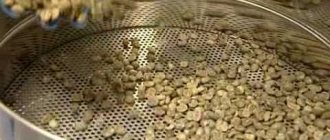Despite the fact that many coffee lovers do not consider instant coffee to be a natural product, it remains very popular all over the world. In Russia alone, at least 40% of buyers choose it. And this love is not accidental. We decided to figure out how instant coffee is created, whether it has any benefits and how, knowing a few simple secrets, you can prepare the most delicious drink. And the answers that we could not find in open sources were given to us by an expert from TEA.ru - an international expert in the field of coffee quality assessment Ilya Goncharov
.
History of instant coffee
The first mention of a coffee drink created from a concentrate dates back to the mid-19th century, but over the years it is quite difficult to establish exactly how this concentrate was prepared and how successful the idea of “canned” coffee was. But it is known for certain that by the beginning of the 20th century, as many as two patents had appeared in the world for the production of instant coffee exactly in the form in which it is known to us now.
The first patent was received by New Zealander David Strang in 1890. He had a small coffee factory and the opportunity to experiment, so already at the end of the 19th century, Australians had the chance to get acquainted with a unique product at that time called “Coffee Strang Instant Dry Powder.” Alas, Strang’s invention did not reach the people: the Australian’s unusual idea was forgotten after his death.
The second patent belonged to the Japanese Satori Kato and was received in 1901. Being a chemist, Kato approached the issue from a more scientific position. He was excellent at justifying the usefulness of his invention and even presented it at the large Pan-American Exhibition in New York. But the Japanese discoverer of instant coffee did not win the laurels of the winner either: although Sato was considered for a long time the author of this product, the world was not yet ready to admire his discovery.
But in 1910, an American of Belgian origin living in Guatemala finally managed to hit the target. Chemist George Constant Washington created and in a large factory launched the production of instant coffee, which was not the first in the world, but it was the first to become widely known. Washington approached the matter like a businessman: he invested in advertising, and then successfully filled the niche of supplying food to the army during World War II. It turned out that dry coffee concentrate is an ideal thing for those cases when a person does not have the opportunity to prepare natural bean coffee for a long time and tastefully. The soldiers of the American troops were deeply grateful to Mr. Washington, brewing the products of his factory in the trenches, and then brought the idea of \u200b\u200bthe instant drink to their homes. It turned out that their wives also prefer not to stand at the stove with a coffee pot, but to prepare their favorite invigorating product in a couple of minutes using hot water.
Then the technology was picked up by Nestlé, which gave instant coffee a chance to become famous throughout the world.
Chemical composition of coffee
Caffeine belongs to the group of alkaloids that stimulate the central nervous system. For the first time, caffeine was obtained from coffee beans, which is why it got its name. The drink owes its tonic effect, increasing mental and physical performance, to caffeine.
According to modern requirements, when making coffee, there must be at least 0.7% caffeine in it, which directly depends on the degree of ripening of the coffee beans and their roasting.
At this concentration, one teaspoon of freshly ground natural coffee will contain 0.1-0.2 grams of pure caffeine, which is quite enough to obtain the appropriate tonic effect.
It is not recommended to exceed the dose of caffeine above 0.3 grams at a time for 3-4 hours - regular excess of the dosage stimulates the manifestation of increased excitability, sleep disturbances, and increased heart function.
Trigonelline is an alkaloid, in its pure form, tasteless and odorless, but during heat treatment it is converted into pyridine, a substance that gives coffee a specific aroma. Another striking chemical property of trigonelline is its close chemical relationship with nicotinic acid (vitamin B3). The nicotinic acid molecule is part of trigonelline and is easily released when heated, which ensures a constant amount of vitamin B3 in the drink.
Vitamin B3 plays a vital role in metabolism in the body and stimulates the activity of the nervous system. A lack of this vitamin leads to a disease such as pellagra.
Nicotinic acid is not the only B vitamin found in coffee beans. After appropriate processing of natural coffee, the drink contains the entire palette of vitamins of this group, as well as:
- the mandatory presence of vitamin A, which is involved in growth and development;
- vitamin D, which improves the absorption of calcium and phosphorus in the intestines;
- vitamin E, which is a participant in the reproduction process and a stimulator of the immune system.
Coffee contains a significant amount of complex organic compounds. These are proteins and amino acids that perform nutritional and energy functions for the cells of the body. Coffee beans are one of the rare plant products that contain essential amino acids that the body gets from meat and fish. Such amino acids are not synthesized in the human body and participate in the restorative functions of cellular mechanisms and maintain immunity at a fairly high level.
Caffeine molecule structure
The total amount of carbohydrates in raw coffee beans is about 50% of its weight. These energetically valuable substances for the body are represented by both simple sugars - sucrose and fructose, and complex polysaccharides - cellulose, fiber, pectin substances, which represent an indispensable basis for the nutrition of nerve cells of the brain.
Mineral substances in coffee include potassium, magnesium and calcium . These inorganic elements make up bones, ensure muscle function, and regulate the functioning of the heart, blood vessels and brain.
Raw coffee beans contain about 850 different essential compounds, and roasted coffee beans contain about 350, which is why coffee has deservedly been awarded the title of the most fragrant drink.
How instant coffee is made
Any instant coffee goes through 3 main stages of production: preparation, extraction and conversion of the extract into a dry product.
It all starts the same.
- In the first step, the raw coffee beans are inspected, roasted, and crushed into large pieces (much larger than any home or restaurant grinder).
- At the second stage, the grains are placed in special tanks, where they are boiled until a concentrate as thick as oil is obtained. Drinking such liquid is dangerous to health - even the strongest heart may not be able to withstand the volume of caffeine contained in it.
- At the third stage, the most interesting part begins: the future instant coffee is transferred from a liquid state to a dry state. This is where the key differences between powdered coffee, granulated and freeze-dried appear.
Powdered coffee (spray dried)
To obtain powdered coffee, concentrated coffee liquid is fed from above through a spray into a narrow, long pipe. There, microscopic droplets dry instantly under the influence of high temperature. The powder, ready for packaging, falls to the bottom of the pipe. What is special about this technology? The fact is that coffee goes through strong heat treatment twice - first it is brewed, then it is dried. At the same time, little remains of the original flavor and aroma.
That is why today this method of producing instant coffee is considered outdated and less successful. Most well-known manufacturers have switched to freeze dried technology (more on this below) and the creation of freeze-dried coffee.
Granulated coffee
Granulated coffee (also known as agglomerated coffee) is produced using the same technology as powdered coffee, but with an additional step in the form of wetting the powder and creating granules from it. This does not affect the taste of the finished drink, but it is more convenient to brew such coffee - it does not stick to the dishes like powdered coffee.
Freeze-dried coffee
Freeze-dried coffee is made by freezing and evaporating. The concentrate is first converted into small ice crystals, and then moisture is removed from these crystals, bypassing the liquid phase and without subjecting the product to additional heating.
This allows you to get a more “natural” instant coffee that retains more taste and aromatic qualities.
Ground in instant
Relatively recently, a new method has emerged that makes instant coffee even closer to the “original” taste: finely ground grains are added to the freeze-dried product. This combination allows, on the one hand, to still quickly prepare the drink by brewing with hot water, and on the other hand, to add taste and aroma to it.
The effect of coffee on human health
Given its rich chemical composition, coffee has both beneficial and negative effects on health, which directly depends on the individual characteristics of a person and the volume of drink consumed per day. The general picture of the effect of a coffee product on the body is as follows:
- regular intake of pure caffeine in an amount of more than 1000 mg, which coffee is richest in, can cause the phenomenon of addiction, similar to drugs or alcohol;
- coffee has a sufficient diuretic effect, so if signs of dehydration appear, it is necessary to increase the amount of fluid you drink;
- In healthy people who do not suffer from high blood pressure, coffee causes a general increase in pressure by 10-15 mmHg. In people suffering from hypertension and related cardiovascular diseases, blood pressure can increase much more strongly or, conversely, decrease, which greatly limits their ability to drink coffee;
- There is no direct effect of caffeine on the heart. Coffee affects cardiac activity indirectly - increasing blood pressure through a stimulating effect on the central nervous system;
- regular use of unfiltered coffee often leads to an increase in total cholesterol in the blood, which inevitably leads to vascular pathologies, characterizing the appearance of problems with blood pressure;
- improvement in attention, productivity, memory and mood is a temporary phenomenon. Depending on the reactivity of the body, this effect disappears after 30-120 minutes;
- coffee enhances the effect of some painkillers, for example, acetylsalicylic acid and analgin, reduces the risk of Parkinson’s and Alzheimer’s diseases due to a temporary vasoconstrictor effect and a direct effect on the neurons of the brain, the so-called “training” effect of these organs occurs;
- Regular consumption of coffee reduces the risk of developing constipation and cirrhosis of the liver, breast cancer in women;
- in older people, coffee reduces the density of skeletal bones, which can cause cracks and fractures;
- people who drink more than two cups of coffee a day have a high risk of developing urolithiasis;
- Pregnant women are not recommended to drink more than a cup of coffee per day. Due to increased blood pressure due to the effects of caffeine, the development of placental anemia, premature birth and low birth weight of the newborn, as well as miscarriages and stillbirths, is possible.
Video on the topic
How instant coffee is made
Click Play to view
The benefits and harms of instant coffee
The benefits of instant coffee
Instant coffee, like regular coffee, is wonderful primarily because it is a caffeine-containing drink, which means it brings us the following beneficial changes:
- release of dopamine and adrenaline, followed by an uplift in mood and a feeling of vigor;
- increasing concentration and cognitive functions of the brain;
- decreased feeling of hunger;
- increasing endurance.
In addition, any coffee, including instant coffee, helps fight the aging of the body, heart and vascular diseases, dementia, the formation of gallstones and the development of diabetes. Coffee is also useful for those who want to lose weight.
Harm of instant coffee
Excess instant (and any other) coffee can lead to disorders such as:
- nervous disorders,
- tachycardia,
- insomnia,
- stimulation of excretory systems.
Doctors do not recommend drinking any coffee (including instant coffee) on an empty stomach, since it is highly acidic. Pregnant and breastfeeding mothers should limit their consumption of instant coffee to 1 cup per day if possible if directed by their doctor.
Nutritional value of coffee
Despite such a diverse composition, coffee made from freshly ground natural beans does not have such a high calorie content, which is due to the easy digestibility of the substances included in its composition. The process of absorption and digestion is further stimulated by caffeine, which is also known to be contained in coffee drinks.
Video on the topic
About the benefits of coffee
Click Play to view
Depending on the type of coffee and the method of its preparation, its nutritional value per 100 grams of sugar-free product is on average:
- proteins, all types - 0.2 g,
- fats - 0.6 g,
- carbohydrates - 0.1 g,
- calcium - up to 5 mg,
- vitamin B3 - 0.6 mg,
- potassium - 9 mg,
- phosphorus - 7 mg,
- iron - 2 mg.
Coffee can have both positive and negative effects on the human body.
Quality criteria
In order to determine the quality of instant coffee, experts conduct a comprehensive analysis of it. The quality criteria are:
- The amount of caffeine contained in the product. It must be at least 2.8%. You can read more about the caffeine content in instant coffee here.
- Moisture content. The maximum permissible rate is 4%, and by the end of the guaranteed storage period - 6%. If this value is exceeded, the coffee may become moldy and spoil.
- Mass fraction of ash. This parameter is checked experimentally by burning and crushing the burnt product. The ash content of natural instant coffee is about 6%, but if this figure is higher than normal, it means that the coffee contains various herbal additives - acorns, chicory.
- Presence of metal impurities. This figure should not be higher than 3 mg/kg.
- The pH value, which reflects the acidity of the product, is at least 4.7.
- Compliance with organoleptic requirements. It must be a brown powdery product, uniform in color, with the aroma and taste characteristic of natural coffee, which are checked during the tasting process. To do this, 2.5 g of coffee is poured into 150 cm3 of water heated to a temperature of 96-98°C.
- Ability to quickly dissolve. In hot water this should happen in 0.5 minutes, in cold water (at a temperature of 20°C) - in 3 minutes. If the powder does not dissolve in water, then it is not instant coffee, but its adulteration.
The rating of the best instant coffee can be found here.
You can find out in detail about all types of coffee with their descriptions at this link.
Read about the difference between espresso and Americano in this material.
Does coffee have energy?
Coffee contains more than 2,000 chemicals and compounds, the totality of which determines its energy, biological and nutritional value.
Coffee calories
The energy value, or calorie content, of whole coffee beans, beans ground into powder, the substrate for instant coffee, and the drink itself varies.
- 100 g of dry, roasted coffee beans contain from 223 to 331 kcal.
- The energy value of 100 g of ground coffee is lower – 200.6 kcal.
- 100 g of dry soluble powder – 119 kcal.
Nutrients in Coffee
The biological value of coffee is assessed taking into account the presence of nutrients in it and the ease of their absorption.
About 61% of the “nutritional set” of raw coffee beans is occupied by non-synthesizable amino acids and proteins, fats, and carbohydrates of the polysaccharide class; another third is insoluble fiber and the remaining 4-5% is caffeine, organic acids, polyphenols, ash and other “organics”.
The mass fraction of fat-like substances in coffee varies from 9.4 to 18%; proteins - from 9 to 19%.
One third of coffee beans consists of fiber, which is why the total percentage of carbohydrates in them reaches 50%. But this has little effect on the calorie content of the drink: during the frying process, carbohydrates are converted into substances that form its taste and aroma.
During the process of roasting and cooking, not only the carbohydrate complex, but also the chemical composition of the grains as a whole changes significantly.
Only a small amount of soluble substances, mainly polysaccharides, “passes” into the water, so the final “alignment” of the coffee cup looks like this:
- The nutritional value of an “average” 100 ml coffee cup is 0.2 mg protein, 0.1 mg carbohydrates and 0.6 mg fat.
- The smallest amount of energy - only 1-2 kcal per 100 ml of drink - comes from black coffee made from whole beans.
- The amount of energy in the ground “brother” is slightly higher – 5-6 kcal.
- Instant coffee has more calories: in a 100 ml mug - 7 kcal.
Microelements (calcium, potassium, iron, phosphorus) and folic acid are present in small quantities in the contents of a coffee cup.
Proteins, fats and carbohydrates
More than half of the substances contained in coffee are carbohydrates. They are responsible for the body of the drink, giving it density and forming a lush foam. Arabica beans contain up to 9% sucrose; in Robusta this figure is lower and amounts to 3-7%.
During heat treatment, most of the sugar is lost. But it is precisely thanks to sugar that, when roasting beans, a chemical reaction is triggered, which leads to the formation of a large amount of organic acids that form the final taste of the drink. The acidity index plays an important role in assessing the quality of a particular variety of Arabica or Robusta.
Proteins in coffee are in free or bound form, they make up 10-13% of the total composition of green beans. The concentration depends on the variety, growing conditions and method of processing the berries. During heating, protein compounds bind to carbohydrates, resulting in the appearance of many new substances that affect the aroma.
These include:
- furans - responsible for the natural sweetness of the drink;
- aldehydes and ketones - add oiliness and light grainy tones, reminiscent of popcorn;
- pyrazines – bring nutty tones.
In total, several hundred aromatic compounds are formed, forming a rich bouquet of the drink. The process begins when the grain is heated to 150 °C and is called the Maillard reaction, named after the French scientist who first studied it.
One of the side effects of this reaction is a change in color. The brown shades of coffee come from melanoidins, which appear at high temperatures. These substances were discovered relatively recently and have been actively studied over the past decade. Scientists have concluded that most melanoidins have powerful antioxidant properties.
The fats in coffee are lipids of plant origin. Their content depends on the variety and degree of roasting. Arabica contains up to 18% fatty acids, the content in Robusta is 13%. Under the influence of high temperature, the structure of substances changes, they take part in the formation of aroma and give the grains a characteristic shine.
Beneficial features
There are many myths about how coffee affects human health, but according to a 2021 study, the drink does much more good than harm. It is noted that its moderate consumption reduces overall mortality. According to one study published in JAMA Internal Medicine, middle-aged Britons who drank coffee in moderation were 10-15% less likely to die (the study period covered 10 years). Another scientific work contains data that coffee reduces the risk of certain types of cancer - oral cavity, endometrium, intestines and skin. This is not all the benefits of coffee: its regular consumption reduces inflammatory processes in the body and allows organs to stay healthy longer, and helps with hypotension increase blood pressure."Freshly brewed ground coffee fits perfectly into various nutrition protocols, especially those aimed at weight loss," nutritionist Veronika Khovanskaya told RIA Novosti. - Moderate caffeine consumption, one to four cups of coffee per day, helps focus and improves mental alertness. By “cup” we mean 100 ml.” April 22, 2021, 1:04 pm Scientists have discovered that coffee changes the sense of taste. According to the expert, the drink has a number of advantages:
- —Coffee contains magnesium and potassium, which help the human body use insulin, regulating blood sugar levels and reducing cravings for sugary treats and snacks.
- —Caffeine helps break down fat and use it as fuel for workouts, which is especially important for men.
- —Coffee contains many antioxidants that protect the body from free radicals.
- —Caffeine reduces insulin sensitivity and glucose tolerance, which reduces the risk of developing type 2 diabetes.
- —Some studies show a beneficial effect of coffee on Parkinson's and Alzheimer's diseases, as it stimulates certain areas of the brain.
- —Coffee improves mood and helps fight depression by stimulating the central nervous system and increasing the production of neurotransmitters such as serotonin, dopamine and norepinephrine.
Due to the content of caffeine, theanine and other substances, the drink can have a beneficial effect on the male body. For example, increase potency and accelerate muscle growth. It is beneficial for women due to its ability to maintain the beauty of hair, skin and nails. Coffee may also reduce the frequency of headache flare-ups. However, the drink is not recommended for children: experts agree that it can only be consumed after puberty.
A little history: how the drink appeared
The first instant mixture was registered at the end of the 18th century. The product was much inferior in taste and aroma to the original version. However, this did not stop him from becoming in demand. The largest buyer was the War Department, which considered this product ideal for field conditions.
Max Morgenthaler, a chemist from Switzerland, helped launch the process of widespread production. He invented a cube made of coffee, sugar and milk. This product could be stored for a long time. In addition, the taste of the drink pleased the tasters.











